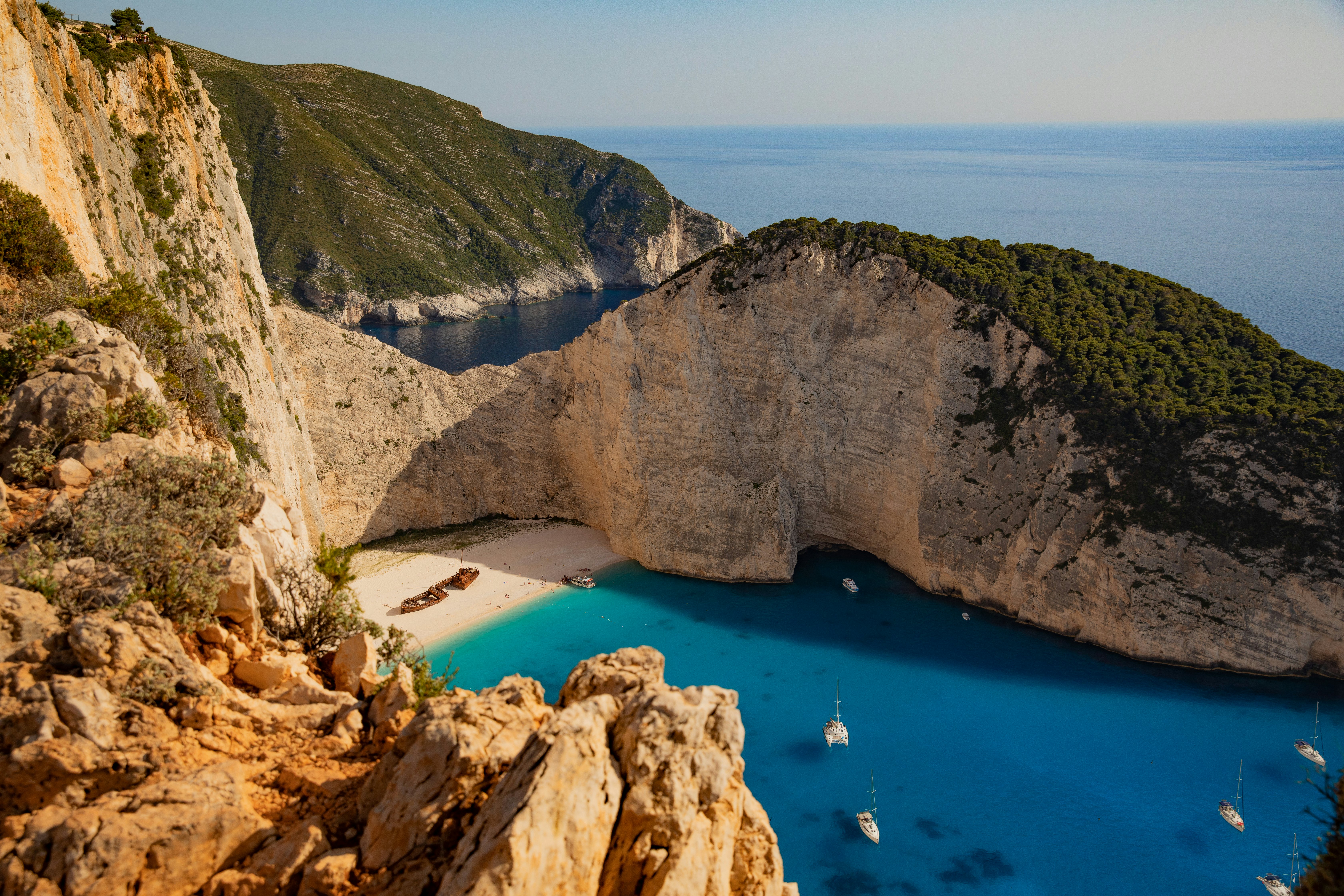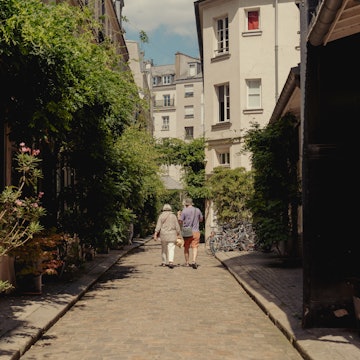

Xigia, on the north coast of Zakynthos. LauraVl/Shutterstock
Sidestep the southern coast's resorts and Zakynthos (sometimes called Zante) just might turn out to be the escape of your wildest Greek island dreams. It has a reputation as a party island, but that atmosphere is mostly contained to the south. With limestone cliffs plummeting into the swirling electric blues of the Ionian Sea, beaches nailing every castaway fantasy, a rugged interior carpeted in olives and grapevines, and ruined Venetian towers standing on lonely promontories commanding sunset views, this Ionian island seduces travelers who slip away from the crowds on foot or by bike, boat or sea kayak.
Sound good? Read on to find out more before your first visit to Zakynthos.
When should I go to Zakynthos?
Zakynthos reaches its boiling point – both in terms of temperature, which frequently tops 30°C (86°F), and visitor numbers (almost three million) – in the peak summer months of July and August, though even then you can find peaceful corners if you go beyond the main resorts. Flight prices go through the roof during the school summer holidays, however, so avoid them if you can.
For weather that is pleasantly warm but not roasting, averaging between 18°C (64°F) and 28°C (82°F), visit during the shoulder months of April, May, June and September. The beaches are far quieter, and it’s a great time for exploring wineries or hiking and biking along the coast. In the low season (October through March), flights and ferries are few, and most places go into hibernation.

How much time should I spend in Zakynthos?
As long as possible. A week is a good benchmark to have time to visit Shipwreck Beach and Gerakas, swim spots like Xigia, and the dramatic caves in the island’s north (Blue Caves) and south (Keri Caves) either by boat or kayak. With a full seven days, you can head into the interior to experience the island's more traditional beat, with wine tasting and dinner among the vines or a stroll in the narrow lanes of time-lost stone villages shaded by ancient olive trees.
Tack on an extra week and you have more lazy beach days as well as trips to dreamy little islets like Cameo Island and Marathonisi.
Where should I base myself in Zakynthos?
Resorts and towns along the coast meet every mood and moment: Zante town, with an appealing mix of tavernas, nightlife, culture and boat trips; party-loving Laganas, Tsilivi and Argassi; and quieter Vassilikos, Alykanas, Kalamaki and Skinari all make great bases for exploring.
Is it easy to get in and around Zakynthos?
In a word: yes. Zakynthos is well connected to the rest of Greece by ferry and Europe by plane. The airport has frequent flights, with airlines including British Airways, EasyJet, Eurowings, TUI and Ryanair. Fast ferries hook up with Kyllini on the Peloponnese (one hour) and the neighboring island Kefalonia (90 minutes). Services tend to be at least daily from mid-May to October.
On Zakynthos itself, getting around is a breeze. You can rent your own wheels (car, moped, bike or e-bike) from most resorts and towns to reach the remoter areas. Otherwise, make use of the KTEL buses that whiz around the island, stopping at all the towns and resorts along the coast. Buses run more frequently during the summer months.
Navagio, better known as Shipwreck Beach. LauraVl/Shutterstock
Top things to do in Zakynthos
Go castaway at Shipwreck Beach
You’ve no doubt seen it on tons of postcards and Instagram posts before, but seeing really is believing when it comes to Zakynthos’ blockbuster northwest coast bay. At Navagio, better known as Shipwreck Beach, vertical cliffs soar high above a perfect wedge of cream sand, fizzing into a sea the color of Blue Curaçao. The centerpiece is a rusting cargo ship that ran aground in the 1980s. The cove is every inch the shipwreck fantasy, and its looks haven’t gone unnoticed: in the summer, everyone wants to capture its beauty from the viewpoint.
Boat tours stop off at the beach – dodge peak summer crowds for a much quieter experience, or be the first to arrive on a speedboat trip with Nefis Travel, looking for dolphins as you bounce across to the bay.
Learn about loggerheads in Gerakas
In Zakynthos’ southeastern crook, the great arc of pale sand at Gerakas Beach is a nesting ground for loggerhead turtles. As conservation is key, visitors are restricted, and the beach is off-limits between dusk and dawn from May to October to allow the turtles to lay their eggs and the hatchlings to find their way to the sea undisturbed. You can get the inside scoop on the turtles at the Zante Turtle Center, just back from the beach.
For more turtle encounters, go kayaking and snorkeling around Marathonisi (aka Turtle Island) with Eco Zante.
Kayak around the Blue Caves
Carved by wind and water over millennia, the limestone cliffs at Zakynthos’ northern tip are indented with sea caves. Most entrancing of the lot are the Blue Caves, which live up to their name. Come in the morning to see sunlight bounce off the pale rock walls and make the water glow in ethereal shades of turquoise, sapphire and aquamarine.
For the full-on drama of the caves, follow the steps down from Skinari Lighthouse to the sea to swim and snorkel around the rocks or board a 40-minute boat trip with Potamis Brothers. To get closer still, sign up for a half-day kayaking trip with Sea Kayaking Zakynthos, dipping your paddle into the inky blue waters and gazing across to Kefalonia.
Dive into island history
Zakynthos swirls in Greek legend and stars in the epic poems Iliad and Odyssey. For island history beyond the coast, step inland to Exo Hora, a time capsule of a mountain village. The gnarly, near-fossilized olive tree in the main square is said to be 2000 years old. From the village's peaceful stone alleys, follow a dirt road to the Venetian watchtower on the promontory for a tremendous view along the island’s west coast – it’s especially gorgeous at sunset.
Taste the nectar of the gods
Viticulture in Zakynthos is rooted in ancient times, but the Venetians really upped the game, busily building terraces and improving the aging and fermentation process. With plenty of sun and cool sea breezes, the vineyards in Zakynthos produce some of Greece’s best wines.
Some of the finest hail from Grampsas Winery in the village of Lagopodo at the foot of Mt Vrachionas. You can take a spin of the cellar before a tasting of the winery’s citrusy white, elegant rosé and full-bodied, peppery red wines in the gardens.
Overlooking the vines, the restaurant puts a sophisticated take on season-spun island flavors, pairing excellent house wines with dishes like vine leaf-baked eggplant with béchamel and beef cheeks, and lamb with sheep cheese foam and Kalamata olives.


My favorite thing to do in Zakynthos
I love getting up as the first rays touch the island and heading to Xigia, a trio of white pebble coves pummeled by startlingly azure waters on Zante's northeast coast. Here you get a free and natural spa treatment bathing in the sulphuric waters that seep out of the limestone cliffs and caves at 20°C (68°F). The mineral-rich water is said to be anti-inflammatory, and floating in the sea before the beachgoers arrive is incredibly relaxing. If you come around midday, the colors are at their brightest, and you can go for drinks or lunch under the pines at the taverna perched above the beach.

How much money do I need for Zakynthos?
Zakynthos is moderately priced as Greek islands go, and costs are on par with the neighboring Ionian Islands. If you’re on a tight budget, you can save with picnic lunches from local bakeries and gyro stands, and stays in simple self-catering apartments and guesthouses costing as little as €50 (US$56) a night. It’s cheaper still to pitch a tent at seafront Camping Tartaruga on the island’s south coast. For the best deals, avoid the peak summer months of July and August.
Self-catering studio or double room in a hotel: €50–100 (US$56–113)
Frappé (iced coffee): €3–5 (US$3.40–5.50)
Mythos beer: €3–5.50 (US$3.40–6)
Gyro: €3–5 (US$3.40–5.50)
One-way bus ticket: €1.80 (US$2)
Taxi from the airport to Zakynthos town: €15–20 (US$17–22.65)
Boat tour to Shipwreck Beach: €30 (US$34)
Car rental per day: from €40 (US$45)
Three-course dinner in a taverna €20–40 (US$28–45)
What should I pack for Zakynthos?
Like many a Greek island, the dress code in Zakynthos is nonexistent. All you’ll need is beachwear and light layers by day, casual clothes for taverna meals, a sun hat, and plenty of sunscreen and mosquito repellent. If you’re planning on swimming from rugged coves, bring water shoes to save your feet from sharp rocks and sea urchins (barely visible from the surface).
Is it safe to walk along the coast?
Generally speaking, yes, but be mindful of where you walk, always avoid the midday heat and take plenty of water to avoid dehydration. Be particularly careful along the sheer cliffs of the west coast, which can be dangerous and exposed, especially above Navagio Beach, as there are no guardrails and it can be windy.























